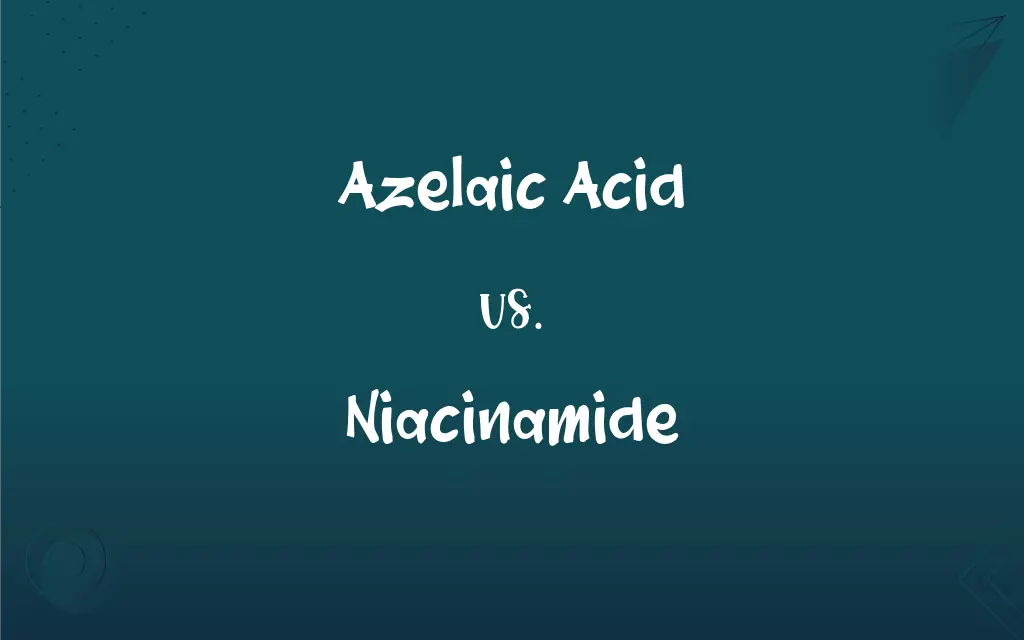Azelaic Acid vs. Niacinamide: What's the Difference?
Edited by Aimie Carlson || By Janet White || Published on January 3, 2024
Azelaic acid is an organic compound used in skincare for its antibacterial and anti-inflammatory properties, while niacinamide is a form of vitamin B3 used for skin hydration and reducing redness.

Key Differences
Azelaic acid, a naturally occurring acid found in grains, is known for its antibacterial properties, making it effective in treating acne. Niacinamide, also known as nicotinamide, is a water-soluble vitamin that works to strengthen the skin barrier and improve skin texture.
In skincare, azelaic acid is used to reduce inflammation and hyperpigmentation, often recommended for rosacea and acne scars. Niacinamide is celebrated for its ability to retain moisture, reduce redness, and minimize the appearance of pores.
Azelaic acid functions by inhibiting the production of keratin, a protein which can block pores and lead to acne, and by reducing melanin production. Niacinamide works by increasing ceramide synthesis in the skin, enhancing its protective barrier and preventing water loss.
The effectiveness of azelaic acid is pronounced in treating mild to moderate acne and evening out skin tone. Niacinamide, being gentler, is suitable for sensitive skin, offering anti-aging benefits by reducing wrinkles and fine lines.
Azelaic acid can be used in higher concentrations for more intense treatments but may cause skin sensitivity. Niacinamide is typically well-tolerated in various concentrations, making it a versatile ingredient in many skincare products.
ADVERTISEMENT
Comparison Chart
Primary Use in Skincare
Treating acne, reducing inflammation
Moisturizing, strengthening skin barrier
Skin Benefits
Reduces hyperpigmentation, treats rosacea
Reduces redness, minimizes pores, anti-aging
Mechanism of Action
Inhibits keratin production, reduces melanin
Increases ceramide synthesis, improves texture
Suitability
Effective for acne-prone skin
Gentle, suitable for sensitive skin
Concentration Usage
Higher concentrations for intense treatment
Well-tolerated in various concentrations
ADVERTISEMENT
Azelaic Acid and Niacinamide Definitions
Azelaic Acid
A dicarboxylic acid used in skincare for its antimicrobial and anti-inflammatory properties.
Azelaic acid is often prescribed for acne treatment due to its antibacterial effects.
Niacinamide
An ingredient known for reducing the appearance of pores and fine lines.
Regular use of niacinamide visibly reduced the size of her pores.
Azelaic Acid
A treatment for rosacea, acne, and for evening out skin tone.
Azelaic acid has been a game-changer in managing her rosacea symptoms.
Niacinamide
A form of vitamin B3 used in skincare to improve barrier function and hydration.
Niacinamide in her moisturizer helped improve her skin's hydration levels.
Azelaic Acid
A component in topical treatments for its skin brightening effects.
Her dermatologist recommended azelaic acid for its skin brightening benefits.
Niacinamide
An active ingredient in anti-aging products for its wrinkle-reducing properties.
She incorporated niacinamide into her routine for its anti-aging benefits.
Azelaic Acid
An acid that inhibits the production of keratin to prevent pore blockage.
Azelaic acid helps prevent acne by stopping excess keratin production.
Niacinamide
A skin-brightening agent that helps even out skin tone.
Niacinamide helped even out her skin tone, giving a brighter complexion.
Azelaic Acid
An organic compound effective in reducing hyperpigmentation and skin redness.
The azelaic acid cream visibly reduced her dark spots within weeks.
Niacinamide
A compound that aids in reducing skin redness and blotchiness.
Niacinamide has been effective in calming her skin's redness.
Niacinamide
(organic compound) The amide of niacin.
Niacinamide
The amide of niacin (nicotinic acid), called also nicotinamide. It was at one time called vitamin B3, and can function to relieve nicotinic acid deficiency. Chemical formula C6H6N2O, chemically it is 3-pyridinecarboxamide.
FAQs
Where does Azelaic Acid come from?
Found in grains like wheat, rye, and barley.
How does Azelaic Acid work on acne?
It reduces inflammation and kills bacteria that cause acne.
What is Niacinamide?
A form of vitamin B3 used in skincare for its anti-inflammatory and antioxidant properties.
What are the main uses of Azelaic Acid?
Used to treat acne, rosacea, and hyperpigmentation.
Is Azelaic Acid suitable for sensitive skin?
Yes, it's generally well-tolerated by sensitive skin types.
What is Azelaic Acid?
A naturally occurring acid used in skincare products for its anti-inflammatory and antimicrobial properties.
Can Azelaic Acid be used with other skincare ingredients?
Yes, but be cautious when combining with other acids or retinoids.
Can Azelaic Acid lighten the skin?
It can help in reducing hyperpigmentation and evening out skin tone.
Is Azelaic Acid safe during pregnancy?
Generally considered safe, but it’s always best to consult a doctor.
What are the side effects of Azelaic Acid?
Possible side effects include skin irritation, itching, and redness.
How long does it take for Azelaic Acid to work?
Results can typically be seen in a few weeks, but it varies per individual.
Can Niacinamide be used for acne?
Yes, it’s effective in reducing inflammation associated with acne.
Is Niacinamide suitable for all skin types?
Yes, it's generally well-tolerated by most skin types.
How often can Niacinamide be used?
It can be used daily, typically in the morning and/or evening.
Does Niacinamide have any side effects?
Rarely, it can cause mild irritation or redness.
What are the benefits of Niacinamide in skincare?
Reduces inflammation, evens skin tone, and improves skin barrier function.
How does Niacinamide help with aging skin?
It helps in reducing fine lines, wrinkles, and improves skin elasticity.
What concentration of Niacinamide is effective in skincare?
Concentrations between 2% to 10% are typically effective.
Can Niacinamide brighten the skin?
Yes, it can help in reducing dark spots and brightening the skin tone.
Can Niacinamide be combined with other skincare ingredients?
Yes, it pairs well with most ingredients, including hyaluronic acid and retinol.
About Author
Written by
Janet WhiteJanet White has been an esteemed writer and blogger for Difference Wiki. Holding a Master's degree in Science and Medical Journalism from the prestigious Boston University, she has consistently demonstrated her expertise and passion for her field. When she's not immersed in her work, Janet relishes her time exercising, delving into a good book, and cherishing moments with friends and family.
Edited by
Aimie CarlsonAimie Carlson, holding a master's degree in English literature, is a fervent English language enthusiast. She lends her writing talents to Difference Wiki, a prominent website that specializes in comparisons, offering readers insightful analyses that both captivate and inform.






































































